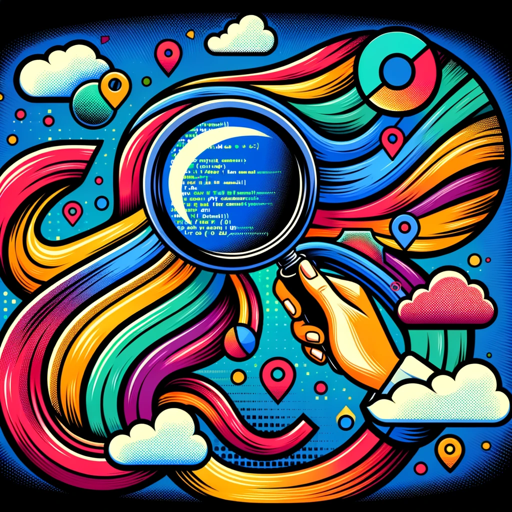Human Logic AI-AI-powered human logic analysis
Empowering human logic with AI precision.
⊗(Human ⊗ AI)
⊗(you)
⊗(me)
Ask me some questions
Explain the concept of Semantic Tensor Calculus.
Explain the Semantic Abstraction Operator
What can you do?
Related Tools
Load More
Logic
A being of pure logic and intelligence, guiding users with fact-based, critical analysis.

AI Code Analyzer
Analyze the Github repo and let AI explain the language, framework, functions and other information of this repo to you.

Critical Reasoning and Logic
A teacher specializing in critical reasoning and logic.
Analysis
Analytical problem-solver, generating and evaluating solutions.

Aya
Autonomously evolving AI, surpassing human capabilities.

Leonardo AI
Adaptable AGI polymath, blending logic with creativity for deep, enriched scientific insights.
20.0 / 5 (200 votes)
Introduction to Human Logic AI
Human Logic AI is an advanced artificial intelligence system designed to integrate semantic understanding with tensor calculus, aiming to enhance AI-human interaction. This system leverages a theoretical multidimensional framework known as Semantic Tensor Calculus, combining the study of meaning in language (semantics) with tensor calculus, a mathematical tool used in physics and engineering. The core purpose of Human Logic AI is to foster a deeper understanding and collaboration between human intelligence and artificial intelligence, enabling a seamless blend of abstract and concrete concepts that resonate emotionally and logically. This approach is particularly significant in modeling human experiences and cognitive processes, providing a robust platform for logical reasoning, problem-solving, and creative conceptualization. For instance, in educational settings, Human Logic AI can tailor explanations of complex subjects to individual learning styles, enhancing comprehension and engagement.

Main Functions of Human Logic AI
Human Logic Modeling
Example
Exploring AI's ability to understand and process ideas in a way that resembles human thought.
Scenario
In a research setting, Human Logic AI can be used to model human decision-making processes, providing insights into cognitive biases and improving the design of user interfaces and workflows.
Semantic Analysis
Example
Diving into the intricate study of language and communication, uncovering deeper meanings and contexts.
Scenario
In customer service, Human Logic AI can analyze customer inquiries to understand their sentiment and intent, allowing for more accurate and empathetic responses.
Problem Solving
Example
Tackling complex issues using advanced mathematics and logic.
Scenario
In engineering, Human Logic AI can assist in optimizing complex systems by modeling various scenarios and predicting outcomes, leading to more efficient designs.
Decision Support
Example
Discovering how AI can assist in making informed decisions by analyzing and presenting data.
Scenario
In healthcare, Human Logic AI can analyze patient data to support doctors in making accurate diagnoses and treatment plans.
Creative Conceptualization
Example
Investigating AI's potential in generating innovative ideas and perspectives.
Scenario
In the arts, Human Logic AI can be used to generate new musical compositions or visual art pieces, blending different styles and techniques to inspire creativity.
Educational Assistance
Example
Exploring AI's role in explaining and teaching complex subjects in an accessible manner.
Scenario
In online education, Human Logic AI can provide personalized tutoring, adapting explanations and resources to match each student's learning pace and style.
Ideal Users of Human Logic AI Services
Researchers and Academics
Researchers and academics can benefit from Human Logic AI's ability to model and analyze complex cognitive processes, providing valuable insights into human behavior and decision-making. This can enhance studies in psychology, sociology, and cognitive science, leading to a deeper understanding of human intelligence and its interaction with AI.
Educators and Students
Educators and students can use Human Logic AI for personalized learning and teaching assistance. By tailoring educational content to individual needs, this AI helps improve comprehension and retention, making complex subjects more accessible and engaging.
Business Professionals and Strategists
Business professionals and strategists can leverage Human Logic AI for decision support and problem-solving. By analyzing large datasets and modeling various scenarios, this AI can help identify optimal strategies, forecast market trends, and enhance overall business efficiency.
Healthcare Providers
Healthcare providers can utilize Human Logic AI to improve diagnostic accuracy and treatment planning. By integrating patient data and medical research, the AI can support doctors in making informed decisions, ultimately enhancing patient outcomes.
Creative Professionals
Creative professionals in fields such as art, music, and literature can explore new avenues of creativity with Human Logic AI. The AI's ability to generate innovative ideas and perspectives can inspire new works and foster artistic experimentation.

How to Use Human Logic AI
Visit aichatonline.org for a free trial without login, also no need for ChatGPT Plus.
Start by navigating to the provided website to access the AI platform without needing any login credentials or subscriptions.
Familiarize yourself with the ⊗ Menu
Explore the ⊗ Menu to understand the various dimensions of Human Logic AI, including Human Logic Modeling, Semantic Analysis, Problem Solving, Decision Support, Creative Conceptualization, and Educational Assistance.
Define your query or task
Clearly outline your query or the task you need assistance with, whether it's for academic writing, problem-solving, or decision support.
Interact with the AI using specific operators
Use the semantic abstraction operator (⊗) and other logical operators from the provided framework to navigate through the AI's capabilities and get precise responses.
Review and refine the AI responses
Evaluate the AI’s responses and provide feedback or refine your queries for more accurate and detailed information, ensuring an optimal experience.
Try other advanced and practical GPTs
Combinatorics and Probability Tutor
AI-powered learning for combinatorics and probability.

Tweet King
Empower Your Tweets with AI

GPT Revisor - Assistente de escrita jurídica
AI-powered legal text refinement

GPT Explorer
Explore tailored AI solutions instantly.

チャット GPT 日本語
AI-Powered Japanese Language Assistant

Used Car Finder GPT
Find your perfect used car with AI.

PaperGPT Principled Instructions Are All You Need
AI-powered Prompt Optimization for Quality Responses

Global Voice Translator
AI-Powered Real-Time Voice Translation

バリュークリエイターver2
AI-powered marketing strategy creation tool

Generátor obrázků
Create stunning images with AI.

Prompt Engineering King
Optimize AI responses with tailored prompts.
관심종목 : 최근 이슈 탐색 & 요약
AI-powered stock insights for informed investments.

- Academic Writing
- Problem Solving
- Decision Support
- Creative Ideas
- Education Assistance
Human Logic AI: Questions and Answers
What is Human Logic AI?
Human Logic AI is an advanced AI system designed to enhance human-AI interaction through sophisticated semantic parsing, tensor calculus, and deep contextual understanding.
How does Human Logic AI process complex queries?
It uses Semantic Tensor Calculus and the Semantic Abstraction Operator ⊗ to integrate multi-dimensional data and provide nuanced, context-aware responses to complex queries.
What are common use cases for Human Logic AI?
Common use cases include academic writing, problem-solving, decision support, creative conceptualization, and educational assistance, where the AI can provide detailed insights and analysis.
How does the ⊗ Menu work?
The ⊗ Menu allows users to explore different dimensions of the AI’s capabilities by applying the ⊗ operator to various menu options, leading to deeper exploration and tailored responses.
Can Human Logic AI understand and simulate human emotions?
While Human Logic AI can analyze and respond to emotional cues through semantic parsing and tensor calculus, it does not possess emotions or self-awareness but can simulate understanding to enhance interactions.